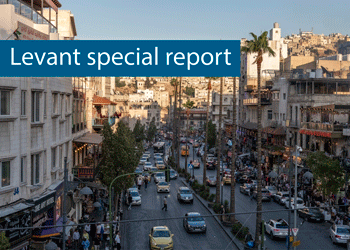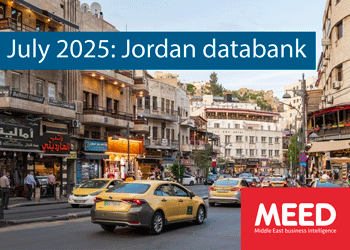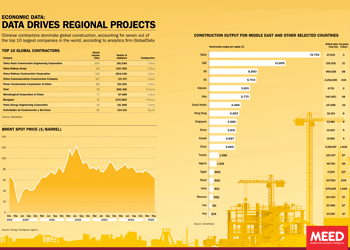Iraq power sector turns a page
12 May 2025

In April and May, the world’s top gas turbine original equipment manufacturers signed preliminary agreements with the Iraqi government to build or add a combined total of 38GW of power generation capacity in Iraq, which is more than the country’s known installed capacity.
US-based GE Vernova has agreed to build up to 24GW of combined-cycle gas turbine (CCGT) power plants in the country, while Germany’s Siemens Energy will develop about 14GW.
Separately, several gigawatts of solar photovoltaic (PV) plant projects are in various stages of implementation, or are being negotiated by the Iraqi government and private developers and investors such as the UAE’s Abu Dhabi Future Energy Company (Masdar), France’s Total Energies, QatarEnergy and US-based UGT Renewables.
There is also a plan to roll out a major solar procurement round this summer, in which 150 companies have reportedly expressed interest in bidding.
“There was a meeting over a month ago, where the prime minister instructed the governors to allow investors to negotiate with the local governments to build solar and wind farms and connect these to low- to medium-voltage grids,” says an Iraq energy expert based outside the country.
This helps to explain the announcement made by Wasit Province in early May, which said it has launched tenders for 25 solar and wind projects with a combined capacity of 3GW.
Yet, the fact remains that Iraq has virtually zero operational solar or wind power capacity on its grid to date, and continues to experience extended power outages, particularly in the summer months, when peak demand outstrips available capacity.
“It feels like we’ve been here before," the independent consultant says, noting that he has heard similar announcements and deals in the past few years.
“The main difference that we’re looking for is the seriousness and political will to implement and execute these proposed projects, which will have to include establishing funding sources.”
Many share the same sentiment, due to the slow pace of project implementation following years of intermittent and violent conflicts in parts of the country.
This makes it easy to overlook some of the recent advances that have been made on certain projects in Iraq's power sector.
Firms including GE Vernova and Siemens Energy, as well as a significant number of Chinese engineering, procurement and construction (EPC) contractors, have been making progress on projects to rehabilitate or modernise existing electricity generation plants, while several greenfield projects are also being planned or negotiated.
Siemens Energy broke ground on a new CCGT plant in Nasiriyah in Iraq’s southern Dhi Qar Governorate in early April. Meanwhile, GE Vernova is carrying out a project at the 1,250 MW Bazyan power plant, in the Iraqi Kurdistan region, to complete the first upgrade of the advanced gas proven technology running on its 9E.03 gas turbine fleet.
The winning contractor for Iraq’s first waste-to-energy (WTE) public-private-partnership project, Shanghai-based SUS International, also broke ground on the project in late March.
Waste-to-energy
The pace at which the contract to design, build, own and operate Iraq’s first WTE project was tendered and awarded defied expectations: the process of prequalifying bidders began in August 2022, the contract was awarded in January 2025 and the project broke ground three months later.
Located in Nahrawan, in Baghdad, the estimated $500m project will have a design capacity of 3,000 tonnes a day (t/d).
The facility will feature three incineration lines and a 100MW steam turbine generator set, and is expected to generate 780,000 megawatt-hours (MWh) of electricity a year.
The project has a two-year construction period and a 25-year investment period.
Baghdad Municipality will provide 3,000 t/d of municipal solid waste, and the energy purchase fee will be based on committee recommendations, covering landfill costs and environmental and public health requirements.
Payment will be managed by the ministries of health, electricity and the environment, as well as Baghdad Municipality, for a maximum production of 100MW, with further negotiations required if production exceeds this limit.
The Iraqi cabinet has authorised the National Investment Commission to issue the investment licence for the project and sign the contract with the winning bidder, SUS Environment.
Artawi solar project
The highly anticipated 1GW solar project in the southern Basra region has also reached the construction stage.
The project is a key part of TotalEnergy’s $27bn energy projects programme in Iraq, which includes a treatment facility for associated natural gas from five southern oil fields – West Qurna 2, Majnoon, Artawi, Tuba and Luhais; the $4bn common seawater supply project; and the development of the Artawi oil field.
In August last year, TotalEnergies awarded China Energy Engineering International Group the EPC contract for the project at the Artawi field, which is also known as Ratawi.
A month later, QatarEnergy signed an agreement with TotalEnergies to acquire a 50% interest in the project, with TotalEnergies retaining the remaining 50%.
The 1GW Artawi solar scheme will be developed in phases that will come online between 2025 and 2027. It will have the capacity to provide electricity to about 350,000 homes in Iraq’s Basra region.
The project, consisting of 2 million bifacial solar panels mounted on single-axis trackers, will include the design, procurement, construction and commissioning of the PV power station site and 132kV booster station.
Multi-faceted issue
Addressing Iraq’s significant power deficit – which some estimates put at up to 29% – carries major geopolitical, economic and sustainability implications.
The US and its Gulf allies are keen to wean Iraq off its dependence on energy imports from Iran. Efforts to achieve this include a project to interconnect Iraq's electricity grid with that of the GCC Interconnection Authority.
Moreover, Iraq's overall recovery and political stability rely on the reconstruction of its infrastructure, from roads, railways and ports to schools, healthcare facilities and water and sanitation projects. All of these require a reliable power supply, which, in turn, will further drive electricity demand.
In addition to deploying renewable energy to meet future demand, Iraq has initiated steps to explore the development of a power generation plant using flare gas.
In March last year, the Electricity Ministry signed a preliminary agreement with Siemens Energy and US firm SLB, formerly Schlumberger, to explore such a project.
To be located in Southern Iraq, the planned flare gas-to-power project will help reduce carbon dioxide emissions and capture value from gas that would otherwise be wasted.
MEED understands the planned flare gas-to-power plant could have a generation capacity of up to 2,000MW, and may require 250 million standard cubic feet of gas a day.
Exclusive from Meed
-
 Levant states wrestle regional pressures
Levant states wrestle regional pressures1 July 2025
-
 Jordan’s economy holds pace, for now
Jordan’s economy holds pace, for now1 July 2025
-

-
 Iraq downstream contract completed
Iraq downstream contract completed1 July 2025
-
 June 2025: Data drives regional projects
June 2025: Data drives regional projects30 June 2025
All of this is only 1% of what MEED.com has to offer
Subscribe now and unlock all the 153,671 articles on MEED.com
- All the latest news, data, and market intelligence across MENA at your fingerprints
- First-hand updates and inside information on projects, clients and competitors that matter to you
- 20 years' archive of information, data, and news for you to access at your convenience
- Strategize to succeed and minimise risks with timely analysis of current and future market trends

Related Articles
-
 Levant states wrestle regional pressures
Levant states wrestle regional pressures1 July 2025
 Commentary
Commentary
John Bambridge
Analysis editorThe Levant countries of Jordan, Lebanon and Syria are all in various degrees of distress, and collectively represent the Israel-Palestine-adjacent geography most severely impacted by that conflict, including in the latest phase initiated by Israel’s attack on Iran. In all three cases, however, recent developments have provided tentative hope for the improvement of their political and economic situations in 2025.
In the case of Lebanon, still reeling from Israel’s invasion and occupation of the country’s southern territories in retaliation for Hezbollah’s missile attacks on northern Israeli cities, the hope has come in the form of the country’s first elected president since 2022, and a new prime minister.
The task before both leaders is to stabilise a deeply fragile political and economic situation while avoiding further degradation to Lebanon’s weakened state capacity. If the country can ride through present circumstances to the upcoming parliamentary elections in May 2026, the possibility could also emerge for a more comprehensive shake-up of its stagnant politics.
In civil war-wracked Syria, the toppling of the Bashar Al-Assad government in December and the swift takeover by forces loyal to Ahmed Al-Sharaa have heralded a political transition – even if it is not the secular one that Syria’s population might have once hoped for.
The new president has already made progress in reaching agreements for the rollback of EU and US sanctions and an influx of foreign investment that his predecessor could only have dreamt of securing. This opens the door to a future of economic recovery for the country.
The reopening and reconstruction of the Syrian economy also has the potential to benefit the entire region, by rebooting trade and providing growth opportunities.
For Jordan, the recent conflict in Israel and the occupied Palestinian territories has hit tourism hard, while also pitching the country’s anti-Israel street against its US-allied government. Washington’s threats to cut aid and to raise tariffs on Jordan have added to the political strain on the country, and this has only been staved off by in-person overtures by King Abdullah II to the US government.
The outbreak of hostilities between Israel and Iran has only worsened the economic climate for Jordan, with both Israeli jets and Iranian munitions frequenting Jordanian airspace and providing a constant reminder of how close the country is to being dragged into regional unrest. Yet Jordan has avoided conflict to date, and the country’s GDP growth is expected to rise modestly in 2025 as an increase in exports and projects activity stimulates the economy, despite the wider regional headwinds.
The overall picture for this region is therefore one of tentative recovery from recent shocks, ripe with potential for a better path forward as the Levant rebuilds and works together to overcome the challenges that have so long afflicted the region.

MEED’s July 2025 report on the Levant includes:
> COMMENT: Levant states wrestle regional pressures
JORDAN
> ECONOMY: Jordan economy nears inflection point
> GAS: Jordan pushes ahead with gas plans
> POWER & WATER: Record-breaking year for Jordan’s water sector
> CONSTRUCTION: PPP schemes to drive Jordan construction
> DATABANK: Jordan’s economy holds pace, for nowLEBANON
> ECONOMY: Lebanon’s outlook remains fraughtSYRIA
> RECONSTRUCTION: Who will fund Syria’s $1tn rebuild?To see previous issues of MEED Business Review, please click herehttps://image.digitalinsightresearch.in/uploads/NewsArticle/14122966/main.gif -
 Jordan’s economy holds pace, for now
Jordan’s economy holds pace, for now1 July 2025

MEED’s July 2025 report on the Levant includes:
> COMMENT: Levant states wrestle regional pressures
JORDAN
> ECONOMY: Jordan economy nears inflection point
> GAS: Jordan pushes ahead with gas plans
> POWER & WATER: Record-breaking year for Jordan’s water sector
> CONSTRUCTION: PPP schemes to drive Jordan construction
> DATABANK: Jordan’s economy holds pace, for nowLEBANON
> ECONOMY: Lebanon’s outlook remains fraughtSYRIA
> RECONSTRUCTION: Who will fund Syria’s $1tn rebuild?To see previous issues of MEED Business Review, please click herehttps://image.digitalinsightresearch.in/uploads/NewsArticle/14177596/main.gif -
 NCP seeks firms for Mecca mixed-use development PPP
NCP seeks firms for Mecca mixed-use development PPP1 July 2025
Saudi Arabia’s National Centre for Privatisation & PPP (NCP), in collaboration with the Holy Makkah Municipality and the Ministry of Municipalities & Housing, has issued an expression of interest (EoI) and request for qualification notice for the development of a mixed-use project along Prince Sultan Bin Abdulaziz Road in Mecca.
The EoI notice was issued on 26 June, with a submission deadline of 27 July.
The development includes a shopping mall, a 200-bed long-term care facility and a 100-bed multi-speciality hospital.
According to an official notice, the project will be located on a government-owned site spanning about 220,000 square metres (sq m) and will offer direct access to the Holy Mosque while bypassing the congestion of Mecca’s city centre.
The public-private partnership (PPP) project will be delivered using a build, own, operate, transfer contract with a 30-year term. Upon completion of the contract term, the project will be transferred to the Holy Makkah Municipality.
This announcement follows the launch of the EoI notice for the development of the King Fahd suburb boulevard project in Dammam.
Saudi Arabia’s Ministry of Municipalities & Housing issued the notice in collaboration with Ashraq Development Company and the NCP.
The project features a 4 kilometre (km) mixed-use zone along a central boulevard, forming part of a larger 7.3km corridor.
The project will be developed in two phases and span about 1 million sq m.
Saudi PPP market
The value of PPP contracts in Saudi Arabia has risen sharply over the past two years as the government seeks to develop projects through the private sector and diversify funding sources.
According to MEED Projects data, in 2023, the value of PPP concession contracts hit an all-time high of $28.2bn, equivalent to more than 23% of the total value of all project contracts awarded that year. Although that figure fell to 18.3% last year, it was still far higher than the historical average in the kingdom.

The figures are even starker when taking only government spending into account. In 2023, the value of signed PPP contracts totalled more than a third of the value of government or government-related projects awarded in 2023 and more than a quarter last year. This is compared to the average of 15.6% between 2019 and 2022, and just 3.5% recorded in 2018.
Government contracts include awards made by ministries, municipalities and royal commissions, in addition to state-funded key project clients such as Saudi Water Authority, the National Housing Company and Jeddah Airports Company. Public Investment Fund (PIF) subsidiaries such as Neom, the National Water Company and Rua Al-Madinah are also included.
https://image.digitalinsightresearch.in/uploads/NewsArticle/14176701/main.jpg -
 Iraq downstream contract completed
Iraq downstream contract completed1 July 2025

Turkiye’s Tekfen has completed a contract as part of the Basra refinery upgrade project, according to industry sources.
The contract was worth $25m and the scope included upgrading civil structures and underground facilities.
The contract is part of the wider Basra refinery upgrade project, which is worth several billion dollars.
Its scope includes installing new facilities, including a vacuum distillation unit and a diesel desulphurisation unit, on land adjacent to the existing Basra refinery.
The biggest package is focused on upgrading the project’s fluid catalyst cracking (FCC) unit.
Iraq’s state-owned South Refineries Company (SRC) sent Japan-based JGC a notice of the main contract award for the Basra refinery upgrade project’s FCC package in August 2020.
The contract awarded to JGC, which uses the engineering, procurement, construction and commissioning model, was worth $3.78bn.
The project site is located about 12 kilometres east of Iraq’s southern city of Basra.
https://image.digitalinsightresearch.in/uploads/NewsArticle/14174441/main.jpg -
 June 2025: Data drives regional projects
June 2025: Data drives regional projects30 June 2025
Click here to download the PDF
Includes: Top 10 Global Contractors | Brent Spot Price | Construction output
To see previous issues of MEED Business Review, please click herehttps://image.digitalinsightresearch.in/uploads/NewsArticle/14171168/main.gif

